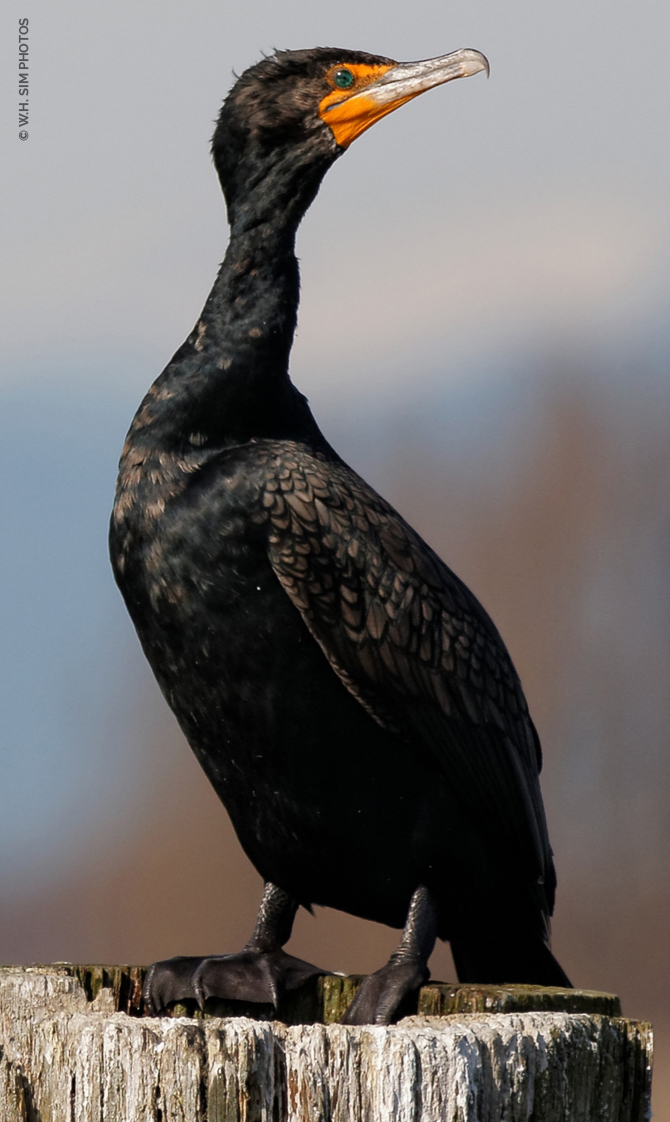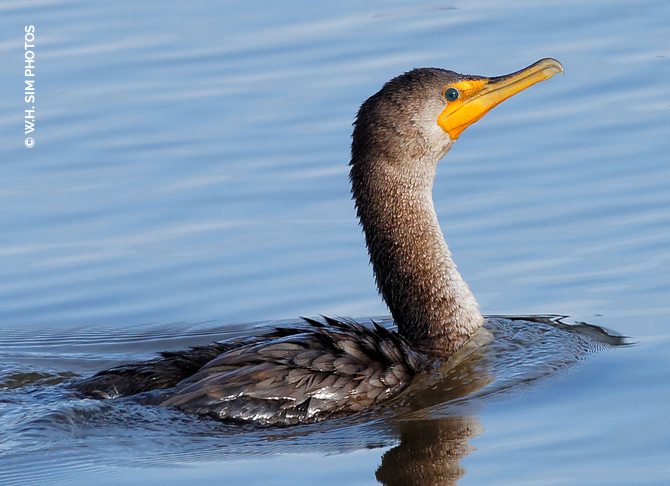This gallery contains 2 photos. Long a bird whom I’ve only seen from afar on dolphins (dock pilings, not the mammals), or doing flyovers in Stanley Park, the Double-Crested Cormorant looks downright prehistoric–right down to its emerald green eyes and yellow face mask. Thanks to these bright facial markings, it is readily identifiable even far away from the drabber and smaller Pelagic and Brandt’s Cormorants. I was finally given the opportunity to (slowly) approach a small number of these large (and generally skittish) fish-eating seabirds as they were catching some sun and drying out their feathers on pilings not far off the edge of Brunswick Point in Delta on March 4, 2015.

for me, no other bird who looks more “out of place in our time” than a cormorant
f/6.3, 1/1600, 500mm, ISO 250
Why are they called “Double-Crested”? Well, during the breeding season, the adults have a pair of black and white crests on the tops of their heads that resemble a badly combed toupee (I’ve never had the opportunity to glimpse one with that particular hairstyle, though). Note how the sunlight falls on the adult in the photo below–there is a distinctive scalloped patterning to its black plumage.
The juvenile Double-Crested Cormorants, like most YASJs, tend to not have as many issues with personal space. This was one of three who were gliding leisurely by me at the Ladner Harbour Park Marina. They resemble the adults to a large degree, except that the former’s feathers are brown, they lack the tufted crests, and the yellow on their faces extends all the way to the hooked tips of their beaks. Photographed on March 18, 2016.

an even closer encounter with a juvenile illustrates the differences in plumage/coloration
f/9, 1/500, 500mm, ISO 640
The long-lived Double-Crested Cormorant is a common coast-to-coast phenomenon on both sides of the continental U.S., as well as many parts of Canada, even though–as with many other bird species–global populations declined significantly in the 1960s with the widespread use of DDT (a pesticide now banned in the North America). Learn more about this remarkable diving seabird by visiting its Cornell Lab of Ornithology profile.
MY ZAZZLE WEBSITE www.zazzle.com/walkswithnature
ON FACEBOOK www.facebook.com/whsimphotography
ON TWITTER www.twitter.com/whuisim
ON GOOGLE+ plus.google.com/u/0/+WHSIM

What a majestic bird, you must have very pleased with your photographs.
LikeLiked by 1 person
Quite pleased. 😀 😀 😀
LikeLike
These are great shots. Good job getting such awesome photos of this very shy bird.
LikeLiked by 1 person
thank you, Leslie!
LikeLike
It is gorgeous this bird.
Very beautiful pictures.
Have a nice day.
LikeLiked by 1 person
thank you, Hervé!
LikeLiked by 1 person
Like your birds. The web feet and colorful face on the first bird make him look very interesting. Thanks for sharing this illusive bird’s picture.
LikeLiked by 1 person
thank you, Peggy!
LikeLiked by 1 person
Prehistoric is right! That’s an interesting critter!
LikeLiked by 1 person
indeed! I wonder what they think of us! 😀
LikeLiked by 1 person
You’re right! This bird DOES look prehistoric. I’ve only ever seen them when we were in the Galapagos.
LikeLiked by 1 person
ah, the Galapagos … another fascinating place that I should visit one day! 🙂
LikeLike
So beautiful and adorable.
LikeLiked by 1 person
adorable is certainly an interesting choice of word! 😉
LikeLike
Such a handsome bird! Your images are fabulous .. My success with taking photos of birds is limited 😃
LikeLiked by 1 person
luck plays a part in photographing wildlife … sometimes a large part. 🙂 but perseverance is a necessity! 🙂
LikeLiked by 1 person
Foto superlative, sono fantastiche!!
LikeLiked by 1 person
thank you, Patrizia! 🙂
LikeLike